Economics for Business: Decentralization and Product Supply in Britain
VerifiedAdded on 2023/06/17
|11
|3159
|69
Essay
AI Summary
This essay explores the influence of economic factors and production decisions on product and commodity availability, focusing on the UK industry. It examines how factors like labor, premises, entrepreneurship, and funding impact production capacity and supply. The essay also analyzes a highly decentralized economy, detailing its effects on the supply of products and commodities in Britain. It further discusses the competitive environment and how it affects supply, including short-term and long-term production considerations, emphasizing improved profits and valuations. The document is available on Desklib, a platform offering study tools and resources for students.
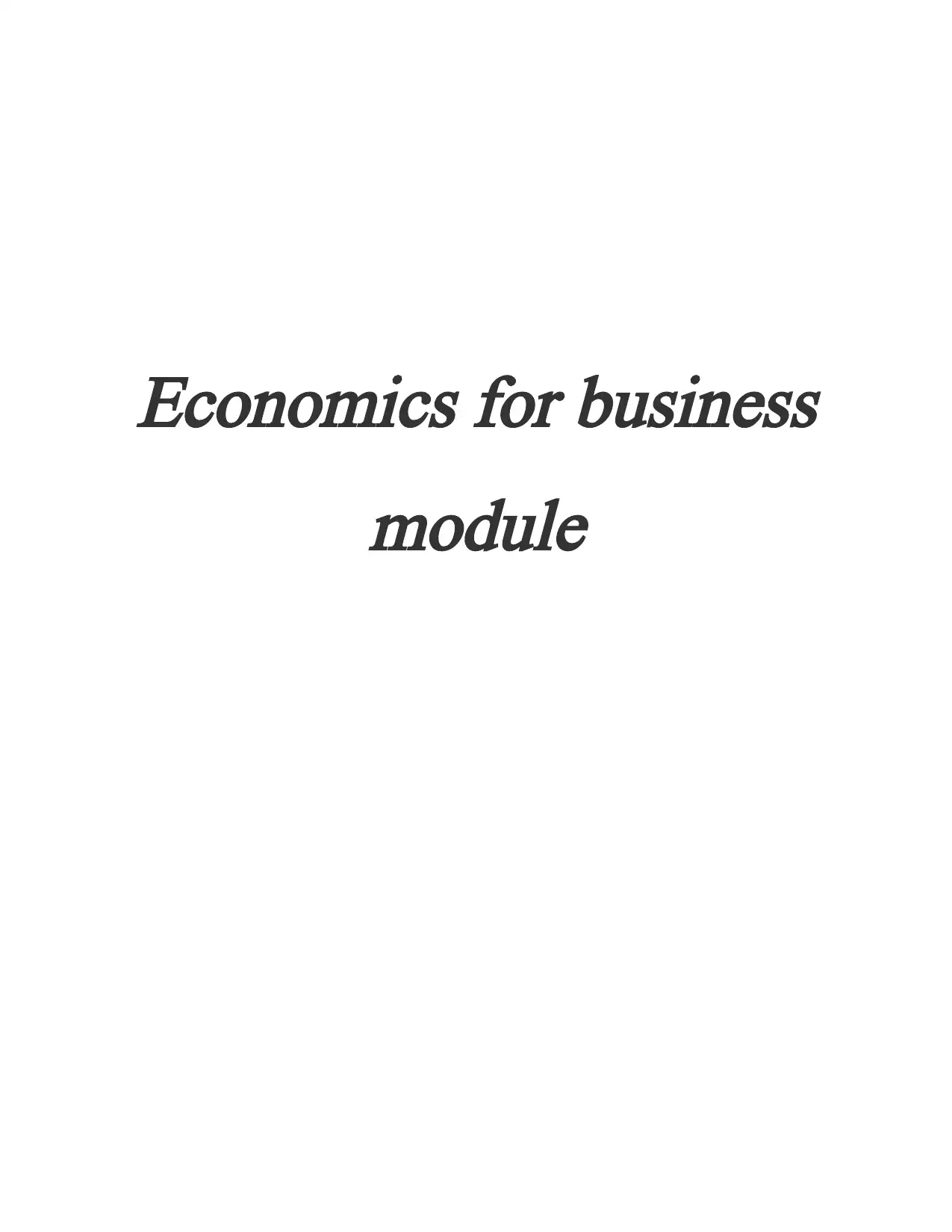
Economics for business
module
module
Paraphrase This Document
Need a fresh take? Get an instant paraphrase of this document with our AI Paraphraser
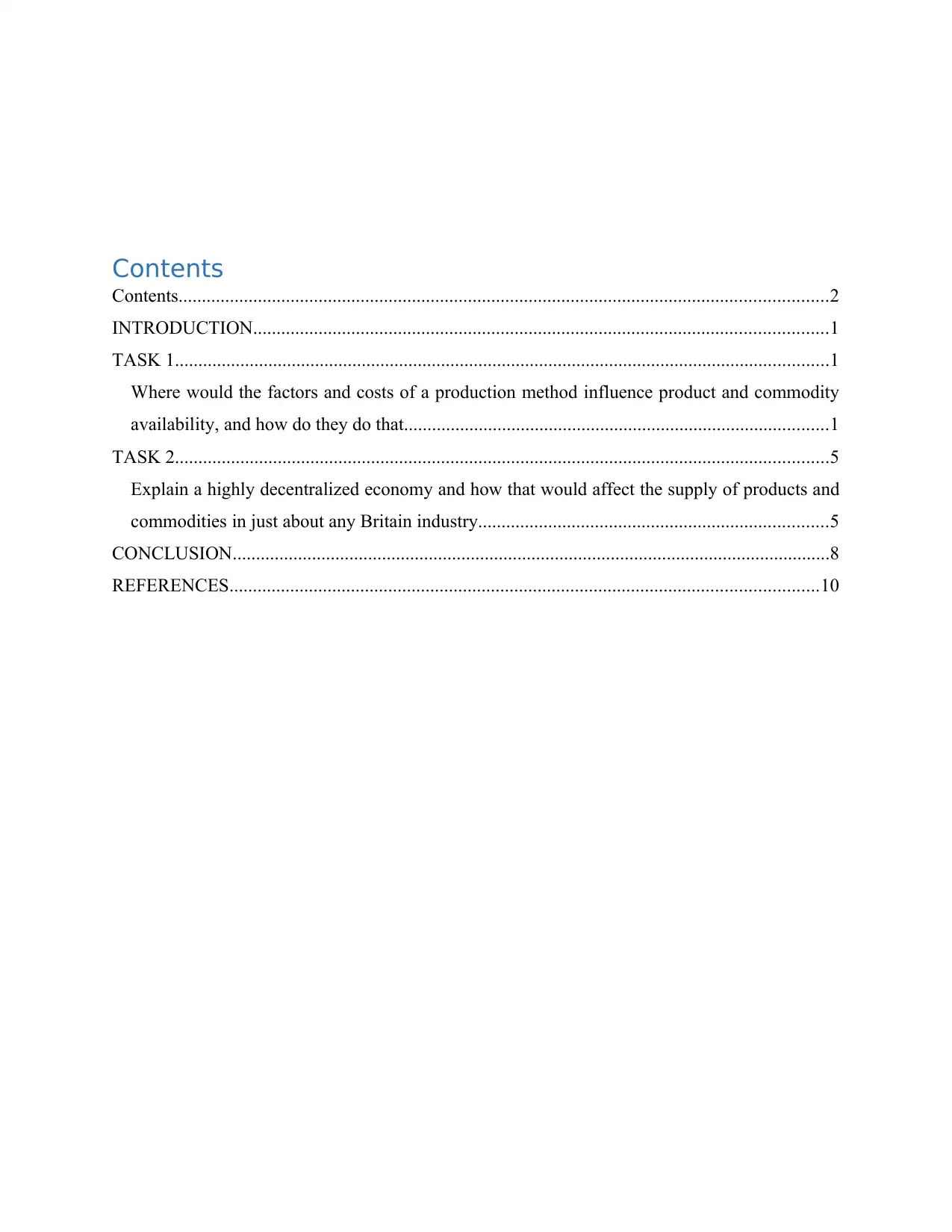
Contents
Contents...........................................................................................................................................2
INTRODUCTION...........................................................................................................................1
TASK 1............................................................................................................................................1
Where would the factors and costs of a production method influence product and commodity
availability, and how do they do that...........................................................................................1
TASK 2............................................................................................................................................5
Explain a highly decentralized economy and how that would affect the supply of products and
commodities in just about any Britain industry...........................................................................5
CONCLUSION................................................................................................................................8
REFERENCES..............................................................................................................................10
Contents...........................................................................................................................................2
INTRODUCTION...........................................................................................................................1
TASK 1............................................................................................................................................1
Where would the factors and costs of a production method influence product and commodity
availability, and how do they do that...........................................................................................1
TASK 2............................................................................................................................................5
Explain a highly decentralized economy and how that would affect the supply of products and
commodities in just about any Britain industry...........................................................................5
CONCLUSION................................................................................................................................8
REFERENCES..............................................................................................................................10
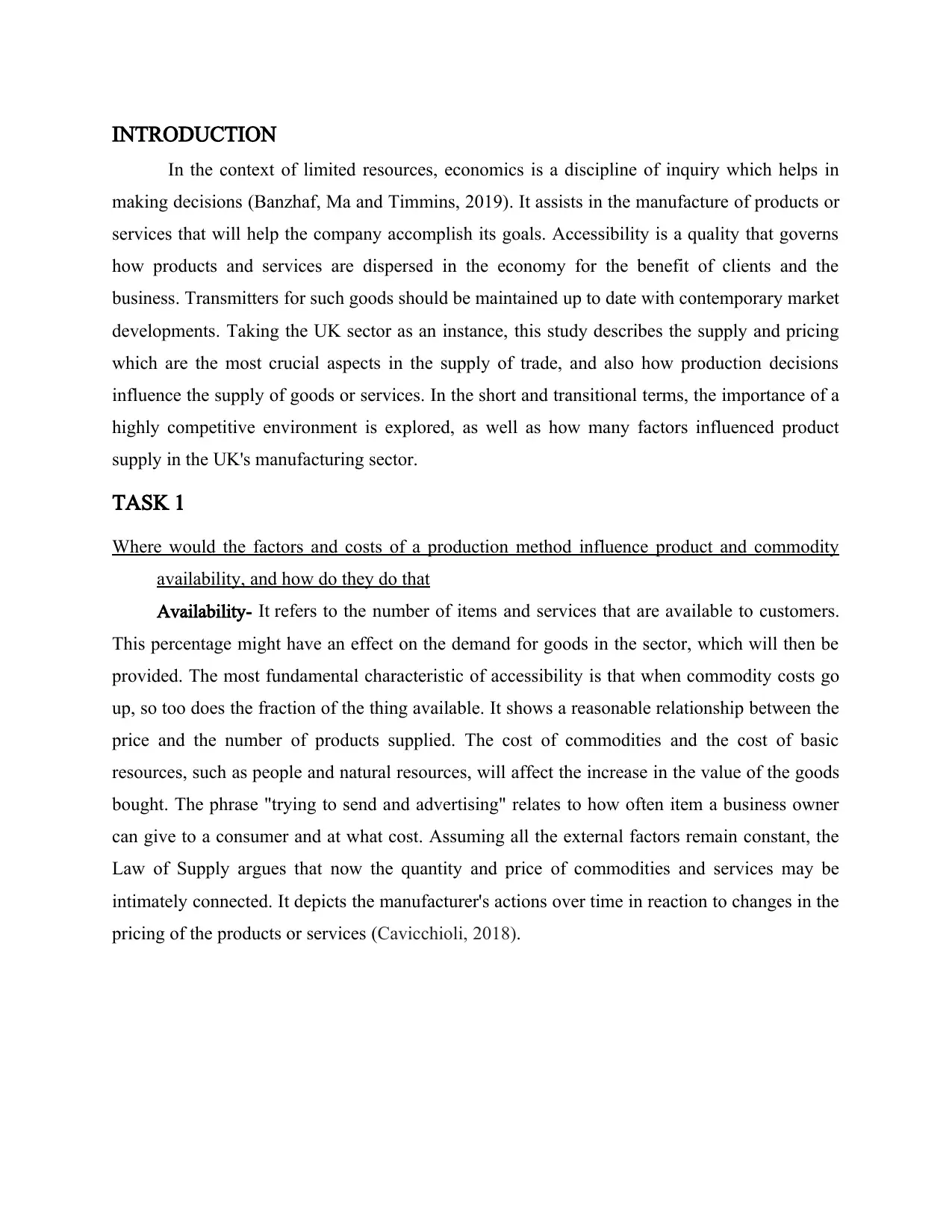
INTRODUCTION
In the context of limited resources, economics is a discipline of inquiry which helps in
making decisions (Banzhaf, Ma and Timmins, 2019). It assists in the manufacture of products or
services that will help the company accomplish its goals. Accessibility is a quality that governs
how products and services are dispersed in the economy for the benefit of clients and the
business. Transmitters for such goods should be maintained up to date with contemporary market
developments. Taking the UK sector as an instance, this study describes the supply and pricing
which are the most crucial aspects in the supply of trade, and also how production decisions
influence the supply of goods or services. In the short and transitional terms, the importance of a
highly competitive environment is explored, as well as how many factors influenced product
supply in the UK's manufacturing sector.
TASK 1
Where would the factors and costs of a production method influence product and commodity
availability, and how do they do that
Availability- It refers to the number of items and services that are available to customers.
This percentage might have an effect on the demand for goods in the sector, which will then be
provided. The most fundamental characteristic of accessibility is that when commodity costs go
up, so too does the fraction of the thing available. It shows a reasonable relationship between the
price and the number of products supplied. The cost of commodities and the cost of basic
resources, such as people and natural resources, will affect the increase in the value of the goods
bought. The phrase "trying to send and advertising" relates to how often item a business owner
can give to a consumer and at what cost. Assuming all the external factors remain constant, the
Law of Supply argues that now the quantity and price of commodities and services may be
intimately connected. It depicts the manufacturer's actions over time in reaction to changes in the
pricing of the products or services (Cavicchioli, 2018).
In the context of limited resources, economics is a discipline of inquiry which helps in
making decisions (Banzhaf, Ma and Timmins, 2019). It assists in the manufacture of products or
services that will help the company accomplish its goals. Accessibility is a quality that governs
how products and services are dispersed in the economy for the benefit of clients and the
business. Transmitters for such goods should be maintained up to date with contemporary market
developments. Taking the UK sector as an instance, this study describes the supply and pricing
which are the most crucial aspects in the supply of trade, and also how production decisions
influence the supply of goods or services. In the short and transitional terms, the importance of a
highly competitive environment is explored, as well as how many factors influenced product
supply in the UK's manufacturing sector.
TASK 1
Where would the factors and costs of a production method influence product and commodity
availability, and how do they do that
Availability- It refers to the number of items and services that are available to customers.
This percentage might have an effect on the demand for goods in the sector, which will then be
provided. The most fundamental characteristic of accessibility is that when commodity costs go
up, so too does the fraction of the thing available. It shows a reasonable relationship between the
price and the number of products supplied. The cost of commodities and the cost of basic
resources, such as people and natural resources, will affect the increase in the value of the goods
bought. The phrase "trying to send and advertising" relates to how often item a business owner
can give to a consumer and at what cost. Assuming all the external factors remain constant, the
Law of Supply argues that now the quantity and price of commodities and services may be
intimately connected. It depicts the manufacturer's actions over time in reaction to changes in the
pricing of the products or services (Cavicchioli, 2018).
⊘ This is a preview!⊘
Do you want full access?
Subscribe today to unlock all pages.

Trusted by 1+ million students worldwide
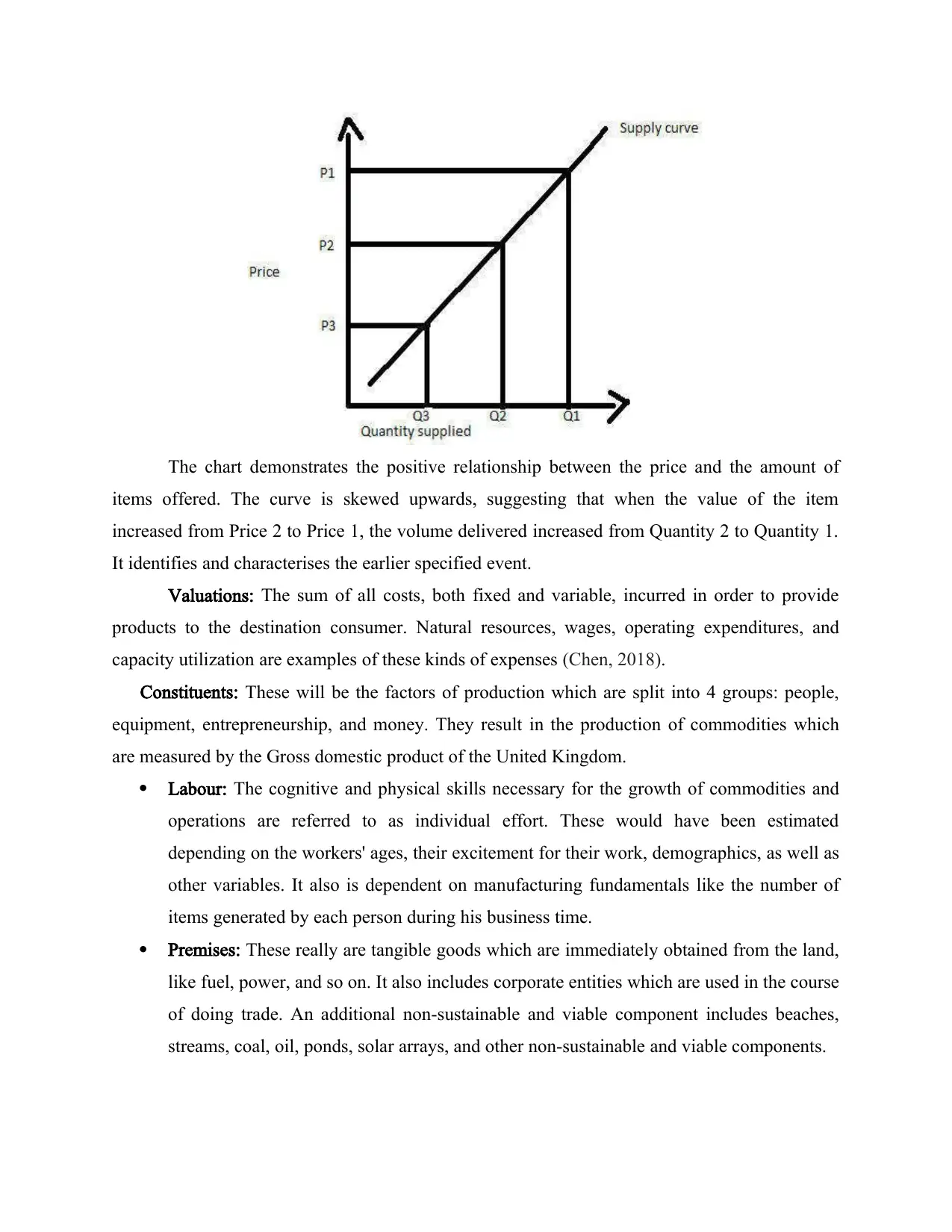
The chart demonstrates the positive relationship between the price and the amount of
items offered. The curve is skewed upwards, suggesting that when the value of the item
increased from Price 2 to Price 1, the volume delivered increased from Quantity 2 to Quantity 1.
It identifies and characterises the earlier specified event.
Valuations: The sum of all costs, both fixed and variable, incurred in order to provide
products to the destination consumer. Natural resources, wages, operating expenditures, and
capacity utilization are examples of these kinds of expenses (Chen, 2018).
Constituents: These will be the factors of production which are split into 4 groups: people,
equipment, entrepreneurship, and money. They result in the production of commodities which
are measured by the Gross domestic product of the United Kingdom.
Labour: The cognitive and physical skills necessary for the growth of commodities and
operations are referred to as individual effort. These would have been estimated
depending on the workers' ages, their excitement for their work, demographics, as well as
other variables. It also is dependent on manufacturing fundamentals like the number of
items generated by each person during his business time.
Premises: These really are tangible goods which are immediately obtained from the land,
like fuel, power, and so on. It also includes corporate entities which are used in the course
of doing trade. An additional non-sustainable and viable component includes beaches,
streams, coal, oil, ponds, solar arrays, and other non-sustainable and viable components.
items offered. The curve is skewed upwards, suggesting that when the value of the item
increased from Price 2 to Price 1, the volume delivered increased from Quantity 2 to Quantity 1.
It identifies and characterises the earlier specified event.
Valuations: The sum of all costs, both fixed and variable, incurred in order to provide
products to the destination consumer. Natural resources, wages, operating expenditures, and
capacity utilization are examples of these kinds of expenses (Chen, 2018).
Constituents: These will be the factors of production which are split into 4 groups: people,
equipment, entrepreneurship, and money. They result in the production of commodities which
are measured by the Gross domestic product of the United Kingdom.
Labour: The cognitive and physical skills necessary for the growth of commodities and
operations are referred to as individual effort. These would have been estimated
depending on the workers' ages, their excitement for their work, demographics, as well as
other variables. It also is dependent on manufacturing fundamentals like the number of
items generated by each person during his business time.
Premises: These really are tangible goods which are immediately obtained from the land,
like fuel, power, and so on. It also includes corporate entities which are used in the course
of doing trade. An additional non-sustainable and viable component includes beaches,
streams, coal, oil, ponds, solar arrays, and other non-sustainable and viable components.
Paraphrase This Document
Need a fresh take? Get an instant paraphrase of this document with our AI Paraphraser

Entrepreneurship: It indicates an owner's ability to withstand unforeseeable threats while
producing items and services. It is a very important as well as crucial aspect as the owner
is the only person who’s decisions make or break the firm and thus the entrepreneur must
be capable of taking appropriate and impactful decisions so that it can help the firm to
attain its goals and objectives in the long run scenario (Filimonau and Gherbin, 2017).
Funding: The entire sum of money spent on developing the activity and items which a
business sells. It includes, among some other factors, the cost of the technologies, the cost
of the building, the cost of the constructions, and the cost of the consumables. A firm
must be sound in terms of finances so that it can sustain and survive I the industry for a
much longer time period as compared to its rivals so that it can prove beneficial for the
firm to be profitable in the market for a prolonged period of time.
Production Decisions: These would be the decisions taken by the company operator to assist
the company and its customers.
The inventory is affected by production factors:
Compensation: Implementing appropriate decision on the producing process used in
selling products will increase the worker knowledge and efficiency, allowing the UK's
GDP to grow. This happens because it represents the actual sum of products and services
generated in the country. It also contributes to current societal improvement by cutting
the cost of a company's wage and giving people with a decent lifestyle. For example, if
the price of products in the manufacturing industry increases, this one will result in an
increase in the amounts offered, which will have an impact on the country's GPD.
Whenever the monetary sector collapsed in 2010 and that there was a material scarcity, it
had an effect on Britain manufacturing (Gillard, 2019).
Outlay: As the years have gone, the quantity of money accessible grows. As a
consequence, whenever suggestions for the sale of commodities are given, the firm's
valuation must be considered. The management is in charge of the facilities which are
required for the country's development. For example, if Britain business contributes
finances in the country by preparing financial statements, but the application process is
long, decision-making might well be postponed. The country's government's
mismanagement of the situation may endanger the whole country and also have a
negative impact.
producing items and services. It is a very important as well as crucial aspect as the owner
is the only person who’s decisions make or break the firm and thus the entrepreneur must
be capable of taking appropriate and impactful decisions so that it can help the firm to
attain its goals and objectives in the long run scenario (Filimonau and Gherbin, 2017).
Funding: The entire sum of money spent on developing the activity and items which a
business sells. It includes, among some other factors, the cost of the technologies, the cost
of the building, the cost of the constructions, and the cost of the consumables. A firm
must be sound in terms of finances so that it can sustain and survive I the industry for a
much longer time period as compared to its rivals so that it can prove beneficial for the
firm to be profitable in the market for a prolonged period of time.
Production Decisions: These would be the decisions taken by the company operator to assist
the company and its customers.
The inventory is affected by production factors:
Compensation: Implementing appropriate decision on the producing process used in
selling products will increase the worker knowledge and efficiency, allowing the UK's
GDP to grow. This happens because it represents the actual sum of products and services
generated in the country. It also contributes to current societal improvement by cutting
the cost of a company's wage and giving people with a decent lifestyle. For example, if
the price of products in the manufacturing industry increases, this one will result in an
increase in the amounts offered, which will have an impact on the country's GPD.
Whenever the monetary sector collapsed in 2010 and that there was a material scarcity, it
had an effect on Britain manufacturing (Gillard, 2019).
Outlay: As the years have gone, the quantity of money accessible grows. As a
consequence, whenever suggestions for the sale of commodities are given, the firm's
valuation must be considered. The management is in charge of the facilities which are
required for the country's development. For example, if Britain business contributes
finances in the country by preparing financial statements, but the application process is
long, decision-making might well be postponed. The country's government's
mismanagement of the situation may endanger the whole country and also have a
negative impact.
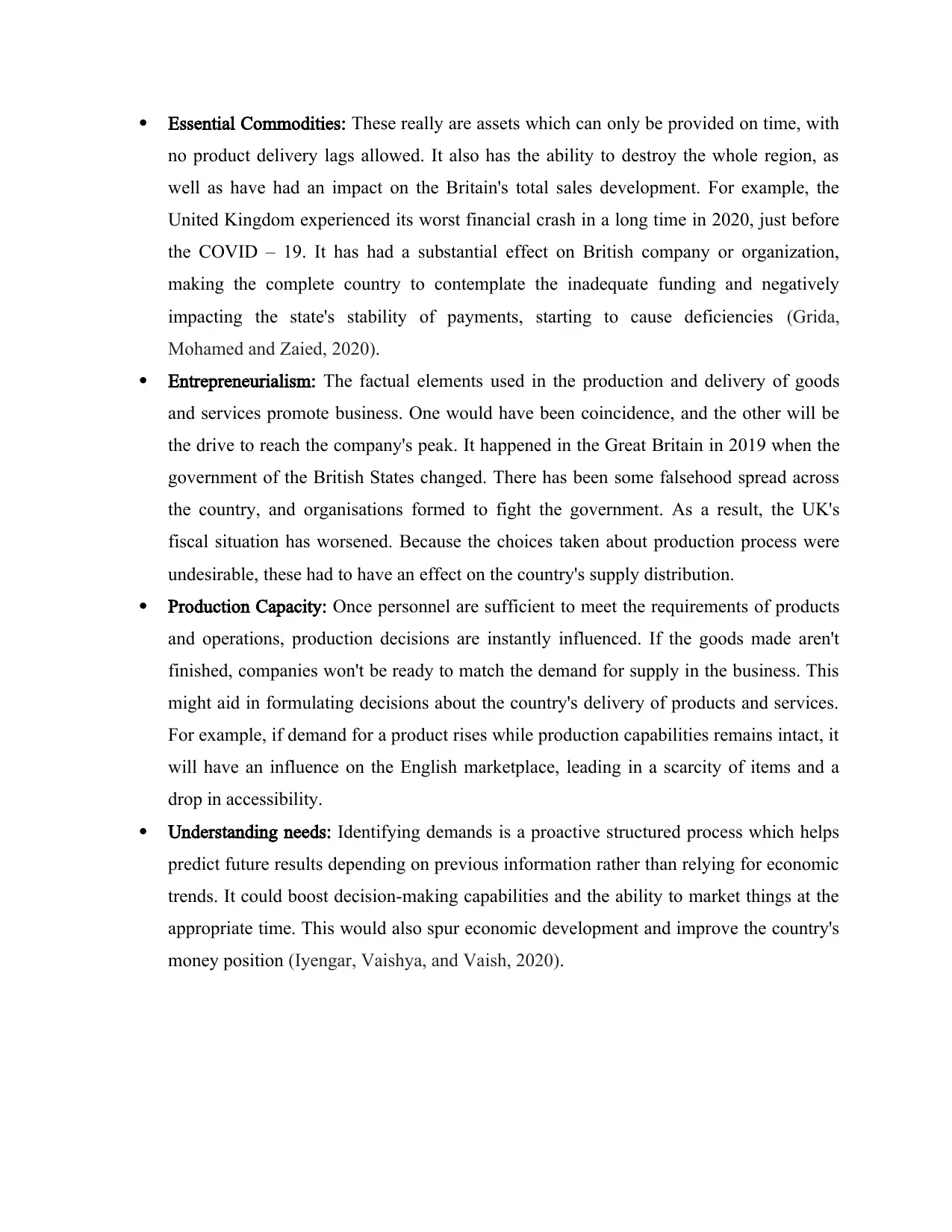
Essential Commodities: These really are assets which can only be provided on time, with
no product delivery lags allowed. It also has the ability to destroy the whole region, as
well as have had an impact on the Britain's total sales development. For example, the
United Kingdom experienced its worst financial crash in a long time in 2020, just before
the COVID – 19. It has had a substantial effect on British company or organization,
making the complete country to contemplate the inadequate funding and negatively
impacting the state's stability of payments, starting to cause deficiencies (Grida,
Mohamed and Zaied, 2020).
Entrepreneurialism: The factual elements used in the production and delivery of goods
and services promote business. One would have been coincidence, and the other will be
the drive to reach the company's peak. It happened in the Great Britain in 2019 when the
government of the British States changed. There has been some falsehood spread across
the country, and organisations formed to fight the government. As a result, the UK's
fiscal situation has worsened. Because the choices taken about production process were
undesirable, these had to have an effect on the country's supply distribution.
Production Capacity: Once personnel are sufficient to meet the requirements of products
and operations, production decisions are instantly influenced. If the goods made aren't
finished, companies won't be ready to match the demand for supply in the business. This
might aid in formulating decisions about the country's delivery of products and services.
For example, if demand for a product rises while production capabilities remains intact, it
will have an influence on the English marketplace, leading in a scarcity of items and a
drop in accessibility.
Understanding needs: Identifying demands is a proactive structured process which helps
predict future results depending on previous information rather than relying for economic
trends. It could boost decision-making capabilities and the ability to market things at the
appropriate time. This would also spur economic development and improve the country's
money position (Iyengar, Vaishya, and Vaish, 2020).
no product delivery lags allowed. It also has the ability to destroy the whole region, as
well as have had an impact on the Britain's total sales development. For example, the
United Kingdom experienced its worst financial crash in a long time in 2020, just before
the COVID – 19. It has had a substantial effect on British company or organization,
making the complete country to contemplate the inadequate funding and negatively
impacting the state's stability of payments, starting to cause deficiencies (Grida,
Mohamed and Zaied, 2020).
Entrepreneurialism: The factual elements used in the production and delivery of goods
and services promote business. One would have been coincidence, and the other will be
the drive to reach the company's peak. It happened in the Great Britain in 2019 when the
government of the British States changed. There has been some falsehood spread across
the country, and organisations formed to fight the government. As a result, the UK's
fiscal situation has worsened. Because the choices taken about production process were
undesirable, these had to have an effect on the country's supply distribution.
Production Capacity: Once personnel are sufficient to meet the requirements of products
and operations, production decisions are instantly influenced. If the goods made aren't
finished, companies won't be ready to match the demand for supply in the business. This
might aid in formulating decisions about the country's delivery of products and services.
For example, if demand for a product rises while production capabilities remains intact, it
will have an influence on the English marketplace, leading in a scarcity of items and a
drop in accessibility.
Understanding needs: Identifying demands is a proactive structured process which helps
predict future results depending on previous information rather than relying for economic
trends. It could boost decision-making capabilities and the ability to market things at the
appropriate time. This would also spur economic development and improve the country's
money position (Iyengar, Vaishya, and Vaish, 2020).
⊘ This is a preview!⊘
Do you want full access?
Subscribe today to unlock all pages.

Trusted by 1+ million students worldwide
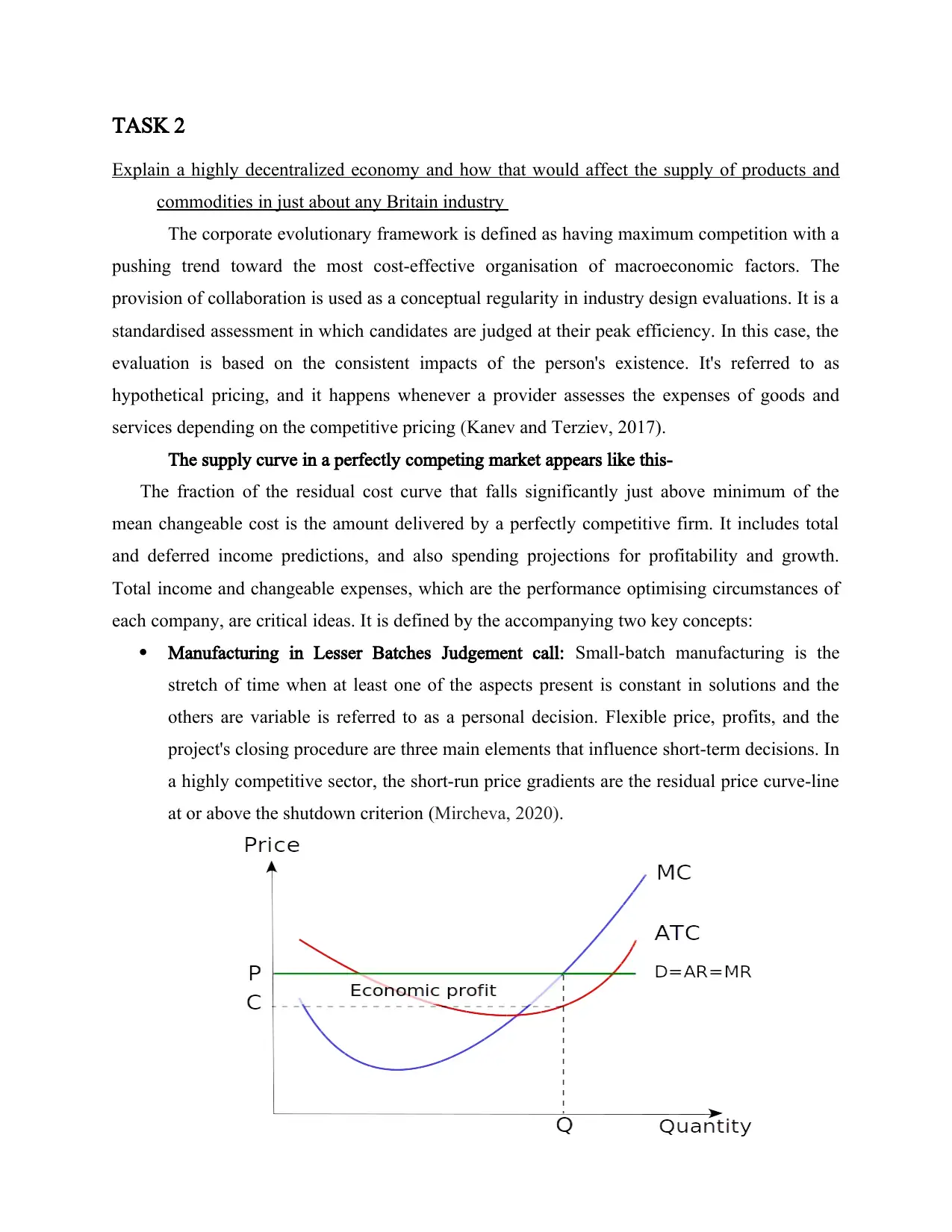
TASK 2
Explain a highly decentralized economy and how that would affect the supply of products and
commodities in just about any Britain industry
The corporate evolutionary framework is defined as having maximum competition with a
pushing trend toward the most cost-effective organisation of macroeconomic factors. The
provision of collaboration is used as a conceptual regularity in industry design evaluations. It is a
standardised assessment in which candidates are judged at their peak efficiency. In this case, the
evaluation is based on the consistent impacts of the person's existence. It's referred to as
hypothetical pricing, and it happens whenever a provider assesses the expenses of goods and
services depending on the competitive pricing (Kanev and Terziev, 2017).
The supply curve in a perfectly competing market appears like this-
The fraction of the residual cost curve that falls significantly just above minimum of the
mean changeable cost is the amount delivered by a perfectly competitive firm. It includes total
and deferred income predictions, and also spending projections for profitability and growth.
Total income and changeable expenses, which are the performance optimising circumstances of
each company, are critical ideas. It is defined by the accompanying two key concepts:
Manufacturing in Lesser Batches Judgement call: Small-batch manufacturing is the
stretch of time when at least one of the aspects present is constant in solutions and the
others are variable is referred to as a personal decision. Flexible price, profits, and the
project's closing procedure are three main elements that influence short-term decisions. In
a highly competitive sector, the short-run price gradients are the residual price curve-line
at or above the shutdown criterion (Mircheva, 2020).
Explain a highly decentralized economy and how that would affect the supply of products and
commodities in just about any Britain industry
The corporate evolutionary framework is defined as having maximum competition with a
pushing trend toward the most cost-effective organisation of macroeconomic factors. The
provision of collaboration is used as a conceptual regularity in industry design evaluations. It is a
standardised assessment in which candidates are judged at their peak efficiency. In this case, the
evaluation is based on the consistent impacts of the person's existence. It's referred to as
hypothetical pricing, and it happens whenever a provider assesses the expenses of goods and
services depending on the competitive pricing (Kanev and Terziev, 2017).
The supply curve in a perfectly competing market appears like this-
The fraction of the residual cost curve that falls significantly just above minimum of the
mean changeable cost is the amount delivered by a perfectly competitive firm. It includes total
and deferred income predictions, and also spending projections for profitability and growth.
Total income and changeable expenses, which are the performance optimising circumstances of
each company, are critical ideas. It is defined by the accompanying two key concepts:
Manufacturing in Lesser Batches Judgement call: Small-batch manufacturing is the
stretch of time when at least one of the aspects present is constant in solutions and the
others are variable is referred to as a personal decision. Flexible price, profits, and the
project's closing procedure are three main elements that influence short-term decisions. In
a highly competitive sector, the short-run price gradients are the residual price curve-line
at or above the shutdown criterion (Mircheva, 2020).
Paraphrase This Document
Need a fresh take? Get an instant paraphrase of this document with our AI Paraphraser
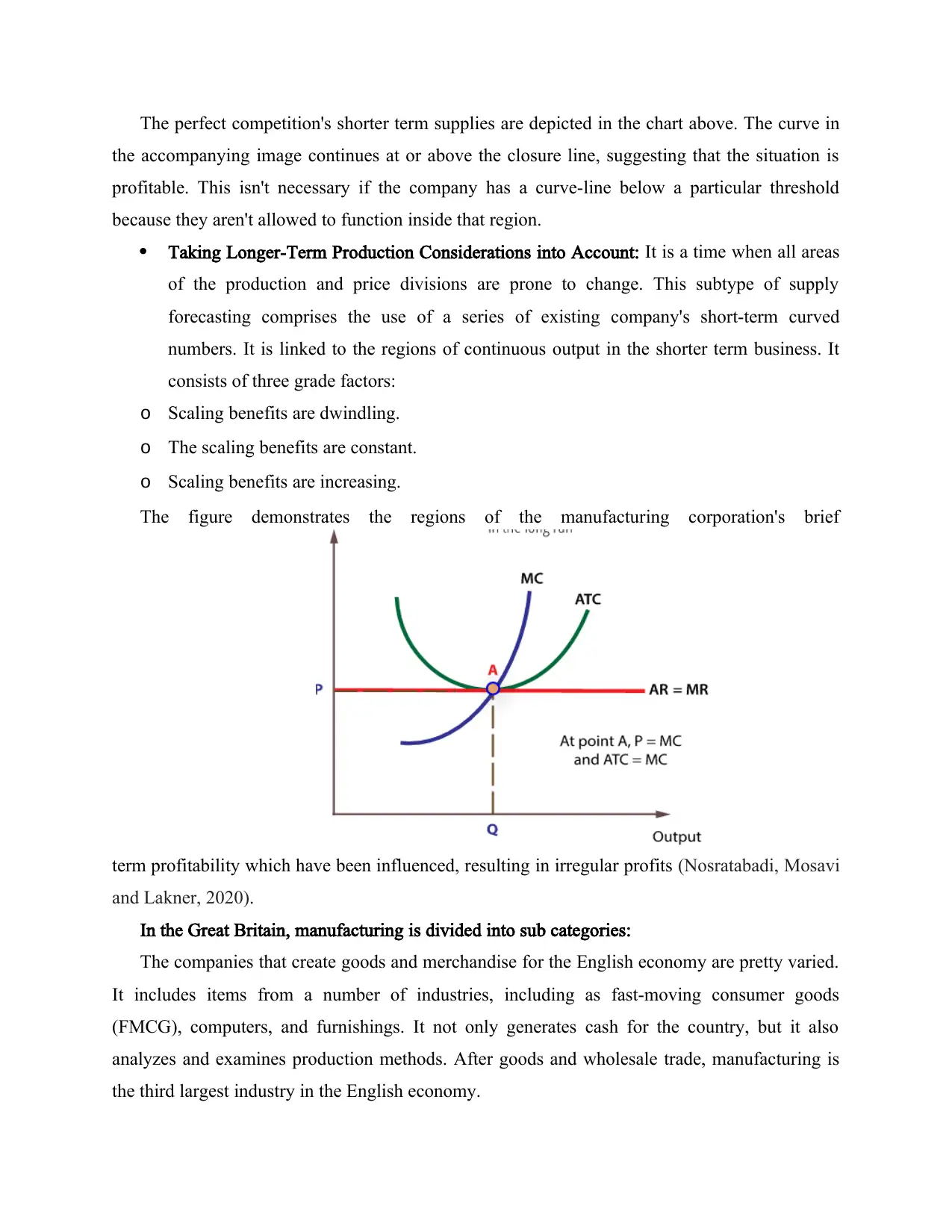
The perfect competition's shorter term supplies are depicted in the chart above. The curve in
the accompanying image continues at or above the closure line, suggesting that the situation is
profitable. This isn't necessary if the company has a curve-line below a particular threshold
because they aren't allowed to function inside that region.
Taking Longer-Term Production Considerations into Account: It is a time when all areas
of the production and price divisions are prone to change. This subtype of supply
forecasting comprises the use of a series of existing company's short-term curved
numbers. It is linked to the regions of continuous output in the shorter term business. It
consists of three grade factors:
o Scaling benefits are dwindling.
o The scaling benefits are constant.
o Scaling benefits are increasing.
The figure demonstrates the regions of the manufacturing corporation's brief
term profitability which have been influenced, resulting in irregular profits (Nosratabadi, Mosavi
and Lakner, 2020).
In the Great Britain, manufacturing is divided into sub categories:
The companies that create goods and merchandise for the English economy are pretty varied.
It includes items from a number of industries, including as fast-moving consumer goods
(FMCG), computers, and furnishings. It not only generates cash for the country, but it also
analyzes and examines production methods. After goods and wholesale trade, manufacturing is
the third largest industry in the English economy.
the accompanying image continues at or above the closure line, suggesting that the situation is
profitable. This isn't necessary if the company has a curve-line below a particular threshold
because they aren't allowed to function inside that region.
Taking Longer-Term Production Considerations into Account: It is a time when all areas
of the production and price divisions are prone to change. This subtype of supply
forecasting comprises the use of a series of existing company's short-term curved
numbers. It is linked to the regions of continuous output in the shorter term business. It
consists of three grade factors:
o Scaling benefits are dwindling.
o The scaling benefits are constant.
o Scaling benefits are increasing.
The figure demonstrates the regions of the manufacturing corporation's brief
term profitability which have been influenced, resulting in irregular profits (Nosratabadi, Mosavi
and Lakner, 2020).
In the Great Britain, manufacturing is divided into sub categories:
The companies that create goods and merchandise for the English economy are pretty varied.
It includes items from a number of industries, including as fast-moving consumer goods
(FMCG), computers, and furnishings. It not only generates cash for the country, but it also
analyzes and examines production methods. After goods and wholesale trade, manufacturing is
the third largest industry in the English economy.
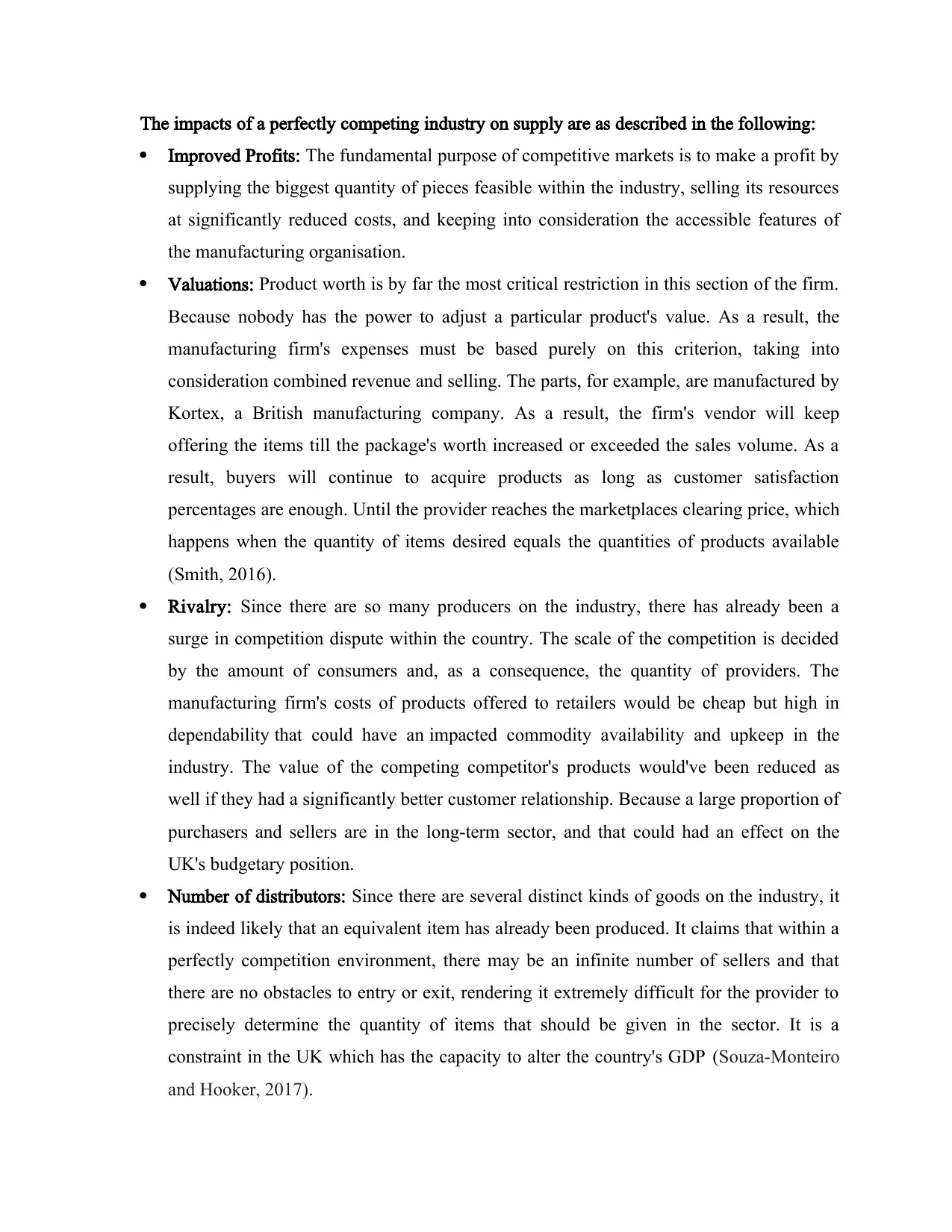
The impacts of a perfectly competing industry on supply are as described in the following:
Improved Profits: The fundamental purpose of competitive markets is to make a profit by
supplying the biggest quantity of pieces feasible within the industry, selling its resources
at significantly reduced costs, and keeping into consideration the accessible features of
the manufacturing organisation.
Valuations: Product worth is by far the most critical restriction in this section of the firm.
Because nobody has the power to adjust a particular product's value. As a result, the
manufacturing firm's expenses must be based purely on this criterion, taking into
consideration combined revenue and selling. The parts, for example, are manufactured by
Kortex, a British manufacturing company. As a result, the firm's vendor will keep
offering the items till the package's worth increased or exceeded the sales volume. As a
result, buyers will continue to acquire products as long as customer satisfaction
percentages are enough. Until the provider reaches the marketplaces clearing price, which
happens when the quantity of items desired equals the quantities of products available
(Smith, 2016).
Rivalry: Since there are so many producers on the industry, there has already been a
surge in competition dispute within the country. The scale of the competition is decided
by the amount of consumers and, as a consequence, the quantity of providers. The
manufacturing firm's costs of products offered to retailers would be cheap but high in
dependability that could have an impacted commodity availability and upkeep in the
industry. The value of the competing competitor's products would've been reduced as
well if they had a significantly better customer relationship. Because a large proportion of
purchasers and sellers are in the long-term sector, and that could had an effect on the
UK's budgetary position.
Number of distributors: Since there are several distinct kinds of goods on the industry, it
is indeed likely that an equivalent item has already been produced. It claims that within a
perfectly competition environment, there may be an infinite number of sellers and that
there are no obstacles to entry or exit, rendering it extremely difficult for the provider to
precisely determine the quantity of items that should be given in the sector. It is a
constraint in the UK which has the capacity to alter the country's GDP (Souza-Monteiro
and Hooker, 2017).
Improved Profits: The fundamental purpose of competitive markets is to make a profit by
supplying the biggest quantity of pieces feasible within the industry, selling its resources
at significantly reduced costs, and keeping into consideration the accessible features of
the manufacturing organisation.
Valuations: Product worth is by far the most critical restriction in this section of the firm.
Because nobody has the power to adjust a particular product's value. As a result, the
manufacturing firm's expenses must be based purely on this criterion, taking into
consideration combined revenue and selling. The parts, for example, are manufactured by
Kortex, a British manufacturing company. As a result, the firm's vendor will keep
offering the items till the package's worth increased or exceeded the sales volume. As a
result, buyers will continue to acquire products as long as customer satisfaction
percentages are enough. Until the provider reaches the marketplaces clearing price, which
happens when the quantity of items desired equals the quantities of products available
(Smith, 2016).
Rivalry: Since there are so many producers on the industry, there has already been a
surge in competition dispute within the country. The scale of the competition is decided
by the amount of consumers and, as a consequence, the quantity of providers. The
manufacturing firm's costs of products offered to retailers would be cheap but high in
dependability that could have an impacted commodity availability and upkeep in the
industry. The value of the competing competitor's products would've been reduced as
well if they had a significantly better customer relationship. Because a large proportion of
purchasers and sellers are in the long-term sector, and that could had an effect on the
UK's budgetary position.
Number of distributors: Since there are several distinct kinds of goods on the industry, it
is indeed likely that an equivalent item has already been produced. It claims that within a
perfectly competition environment, there may be an infinite number of sellers and that
there are no obstacles to entry or exit, rendering it extremely difficult for the provider to
precisely determine the quantity of items that should be given in the sector. It is a
constraint in the UK which has the capacity to alter the country's GDP (Souza-Monteiro
and Hooker, 2017).
⊘ This is a preview!⊘
Do you want full access?
Subscribe today to unlock all pages.

Trusted by 1+ million students worldwide
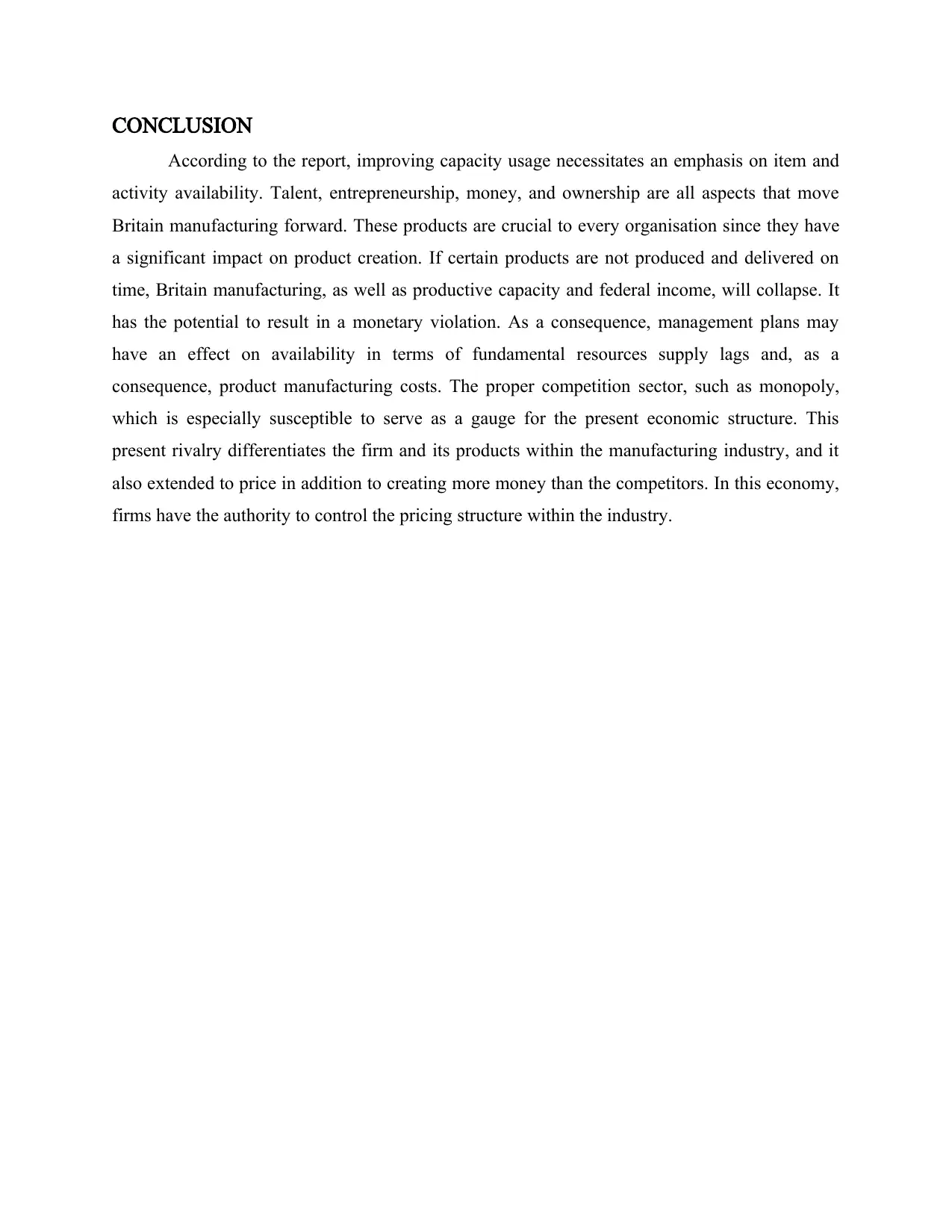
CONCLUSION
According to the report, improving capacity usage necessitates an emphasis on item and
activity availability. Talent, entrepreneurship, money, and ownership are all aspects that move
Britain manufacturing forward. These products are crucial to every organisation since they have
a significant impact on product creation. If certain products are not produced and delivered on
time, Britain manufacturing, as well as productive capacity and federal income, will collapse. It
has the potential to result in a monetary violation. As a consequence, management plans may
have an effect on availability in terms of fundamental resources supply lags and, as a
consequence, product manufacturing costs. The proper competition sector, such as monopoly,
which is especially susceptible to serve as a gauge for the present economic structure. This
present rivalry differentiates the firm and its products within the manufacturing industry, and it
also extended to price in addition to creating more money than the competitors. In this economy,
firms have the authority to control the pricing structure within the industry.
According to the report, improving capacity usage necessitates an emphasis on item and
activity availability. Talent, entrepreneurship, money, and ownership are all aspects that move
Britain manufacturing forward. These products are crucial to every organisation since they have
a significant impact on product creation. If certain products are not produced and delivered on
time, Britain manufacturing, as well as productive capacity and federal income, will collapse. It
has the potential to result in a monetary violation. As a consequence, management plans may
have an effect on availability in terms of fundamental resources supply lags and, as a
consequence, product manufacturing costs. The proper competition sector, such as monopoly,
which is especially susceptible to serve as a gauge for the present economic structure. This
present rivalry differentiates the firm and its products within the manufacturing industry, and it
also extended to price in addition to creating more money than the competitors. In this economy,
firms have the authority to control the pricing structure within the industry.
Paraphrase This Document
Need a fresh take? Get an instant paraphrase of this document with our AI Paraphraser
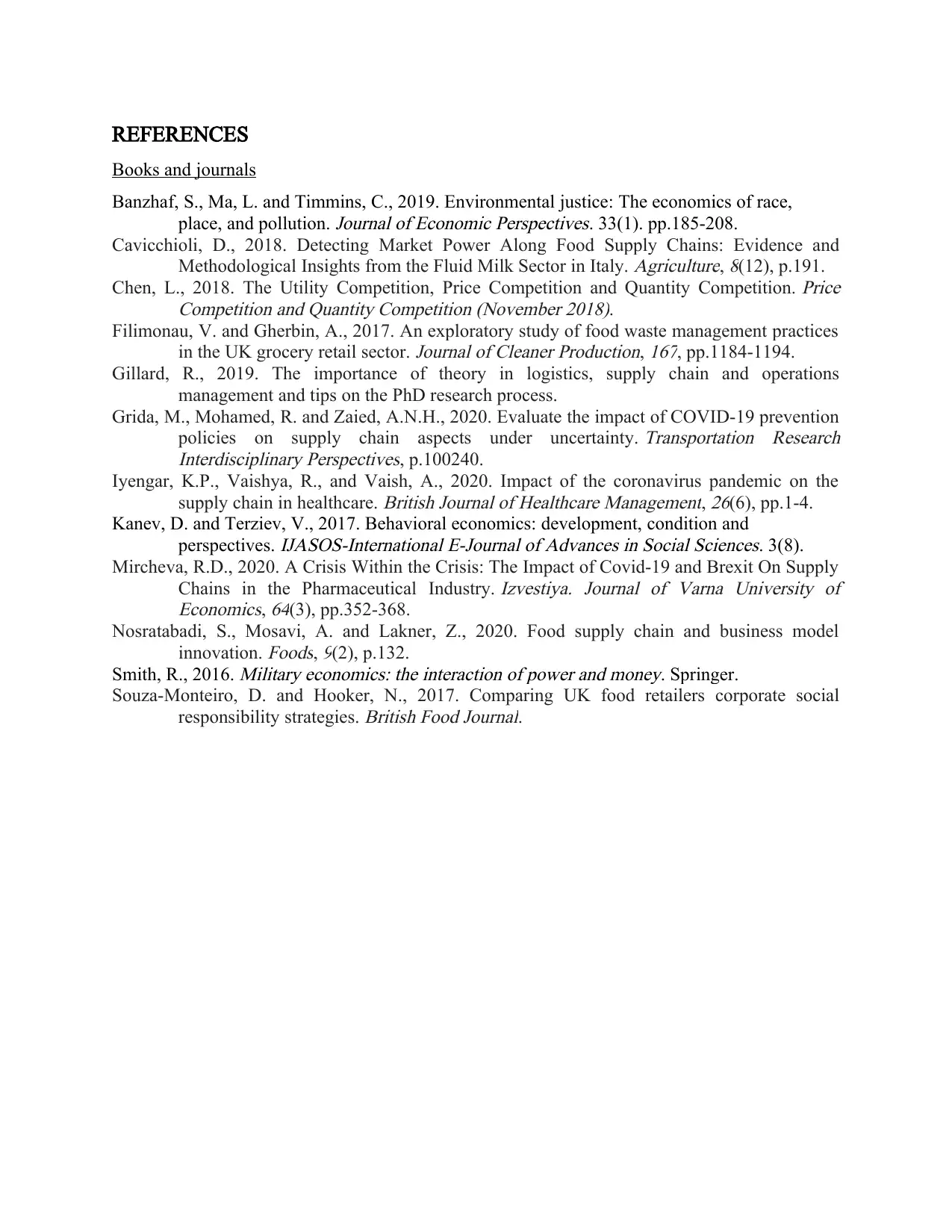
REFERENCES
Books and journals
Banzhaf, S., Ma, L. and Timmins, C., 2019. Environmental justice: The economics of race,
place, and pollution.
Journal of Economic Perspectives. 33(1). pp.185-208.
Cavicchioli, D., 2018. Detecting Market Power Along Food Supply Chains: Evidence and
Methodological Insights from the Fluid Milk Sector in Italy.
Agriculture,
8(12), p.191.
Chen, L., 2018. The Utility Competition, Price Competition and Quantity Competition.
Price
Competition and Quantity Competition (November 2018).
Filimonau, V. and Gherbin, A., 2017. An exploratory study of food waste management practices
in the UK grocery retail sector.
Journal of Cleaner Production,
167, pp.1184-1194.
Gillard, R., 2019. The importance of theory in logistics, supply chain and operations
management and tips on the PhD research process.
Grida, M., Mohamed, R. and Zaied, A.N.H., 2020. Evaluate the impact of COVID-19 prevention
policies on supply chain aspects under uncertainty.
Transportation Research
Interdisciplinary Perspectives, p.100240.
Iyengar, K.P., Vaishya, R., and Vaish, A., 2020. Impact of the coronavirus pandemic on the
supply chain in healthcare.
British Journal of Healthcare Management,
26(6), pp.1-4.
Kanev, D. and Terziev, V., 2017. Behavioral economics: development, condition and
perspectives.
IJASOS-International E-Journal of Advances in Social Sciences. 3(8).
Mircheva, R.D., 2020. A Crisis Within the Crisis: The Impact of Covid-19 and Brexit On Supply
Chains in the Pharmaceutical Industry.
Izvestiya. Journal of Varna University of
Economics,
64(3), pp.352-368.
Nosratabadi, S., Mosavi, A. and Lakner, Z., 2020. Food supply chain and business model
innovation.
Foods,
9(2), p.132.
Smith, R., 2016.
Military economics: the interaction of power and money. Springer.
Souza-Monteiro, D. and Hooker, N., 2017. Comparing UK food retailers corporate social
responsibility strategies.
British Food Journal.
Books and journals
Banzhaf, S., Ma, L. and Timmins, C., 2019. Environmental justice: The economics of race,
place, and pollution.
Journal of Economic Perspectives. 33(1). pp.185-208.
Cavicchioli, D., 2018. Detecting Market Power Along Food Supply Chains: Evidence and
Methodological Insights from the Fluid Milk Sector in Italy.
Agriculture,
8(12), p.191.
Chen, L., 2018. The Utility Competition, Price Competition and Quantity Competition.
Price
Competition and Quantity Competition (November 2018).
Filimonau, V. and Gherbin, A., 2017. An exploratory study of food waste management practices
in the UK grocery retail sector.
Journal of Cleaner Production,
167, pp.1184-1194.
Gillard, R., 2019. The importance of theory in logistics, supply chain and operations
management and tips on the PhD research process.
Grida, M., Mohamed, R. and Zaied, A.N.H., 2020. Evaluate the impact of COVID-19 prevention
policies on supply chain aspects under uncertainty.
Transportation Research
Interdisciplinary Perspectives, p.100240.
Iyengar, K.P., Vaishya, R., and Vaish, A., 2020. Impact of the coronavirus pandemic on the
supply chain in healthcare.
British Journal of Healthcare Management,
26(6), pp.1-4.
Kanev, D. and Terziev, V., 2017. Behavioral economics: development, condition and
perspectives.
IJASOS-International E-Journal of Advances in Social Sciences. 3(8).
Mircheva, R.D., 2020. A Crisis Within the Crisis: The Impact of Covid-19 and Brexit On Supply
Chains in the Pharmaceutical Industry.
Izvestiya. Journal of Varna University of
Economics,
64(3), pp.352-368.
Nosratabadi, S., Mosavi, A. and Lakner, Z., 2020. Food supply chain and business model
innovation.
Foods,
9(2), p.132.
Smith, R., 2016.
Military economics: the interaction of power and money. Springer.
Souza-Monteiro, D. and Hooker, N., 2017. Comparing UK food retailers corporate social
responsibility strategies.
British Food Journal.
1 out of 11
Related Documents
Your All-in-One AI-Powered Toolkit for Academic Success.
+13062052269
info@desklib.com
Available 24*7 on WhatsApp / Email
![[object Object]](/_next/static/media/star-bottom.7253800d.svg)
Unlock your academic potential
Copyright © 2020–2025 A2Z Services. All Rights Reserved. Developed and managed by ZUCOL.



